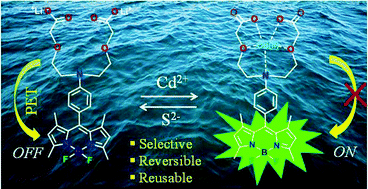A water-soluble BODIPY based ‘OFF/ON’ fluorescent probe for the detection of Cd2+ ions with high selectivity and sensitivity†
Abstract
A water-soluble dilithium salt BODIPY derivative (LiBDP) with appended dicarboxylate pseudo-crown ether [NO4] coordinating sites has been designed, synthesized and characterized successfully for the selective and sensitive recognition of Cd2+ in aqueous media. The chemosensor exhibits a remarkable increase in fluorescence intensity as well as a distinct color change upon the addition of Cd2+ over other environmentally and biologically relevant metal ions in H2O. The fluorometric response of LiBDP is attributed to the metal chelation-enhanced fluorescence (MCHEF) effect which has been confirmed by a strong association constant of 2.57 ± 1.06 × 105 M−1 and Job's plot, indicating 1 : 1 binding stoichiometry between LiBDP and Cd2+. Frontier molecular orbital analysis (obtained from DFT studies) also illustrates the turn-on fluorescence of the probe by blocking photoinduced electron transfer (PET) after coordination to Cd2+. The probe can detect Cd2+ in a competitive environment up to a submicromolar level in a biologically significant pH range. The sensor is proved to be reversible and reusable by the alternative addition of Cd2+ followed by S2−. The OFF/ON/OFF sensing behavior is utilized to construct an INHIBIT molecular logic gate based on the two inputs of Cd2+ and S2− and a fluorescence intensity at 512 nm as an output. The test paper experiment demonstrates the practical utility of LiBDP to monitor Cd2+ in an aqueous sample. Finally, the sensing probe was utilized to monitor Cd2+ in living cells.



 Please wait while we load your content...
Please wait while we load your content...